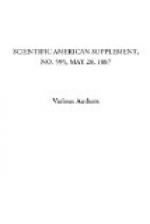I must now make a digression. It must not be assumed that every one has the same sense of color, otherwise there would be no color blindness. Part of the researches of General Festing and myself have been on the subject of color blindness, and these I must briefly refer to. We test all who come by making them match the luminosity of colors with white light, as I have now shown you. And as a color blind person has only two fundamental color perceptions instead of three, his matching of luminosities is even more accurate than is that made by those whose eyes are normal or nearly normal. It is curious to note how many people are more or less deficient in color perception. Some have remarked that it is impossible that they were color blind and would not believe it, and sometimes we have been staggered at first with the remarkable manner in which they recognized color to which they ultimately proved deficient in perception. For instance, one gentleman when I asked him the name of a red color patch, said it was sunset color. He then named green and blue correctly, but when I reverted to the red patch he said green.
On testing further, he proved totally deficient in the color perception of red, and with a brilliant red patch he matched almost a black shadow. The diagram shows you the relative perceptions in the spectrum of this gentleman and myself. There are others who only see three-quarters, others half, and others a quarter the amount of red that we see, while some see none. Others see less green and others less violet, but I have met with no one that can see more than myself or General Festing, whose color perceptions are almost identical. Hence we have called our curve of illumination the “normal curve.”
We have tested several eminent artists in this manner, and about one half of the number have been proved to see only three quarters of the amount of red which we see. It might be thought that this would vitiate their powers of matching color, but it is not so. They paint what they see; and although they see less red in a subject, they see the same deficiency in their pigments; hence they are correct. If totally deficient, the case of course would be different.
Let us carry our experiments a step further, and see what effect what is known as a turbid medium has upon the illuminating value of different parts of the spectrum. I have here water which has been rendered turbid in a very simple manner. In it has been very cautiously dropped an alcoholic solution of mastic. Now mastic is practically insoluble in water, and directly the alcoholic solution comes in contact with the water it separates out in very fine particles, which, from their very fineness, remain suspended in the water. I propose now to make an experiment with this turbid water.




